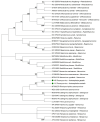Novel paramyxovirus in wild pinnipeds, Brazil
- PMID: 40591094
- PMCID: PMC12213916
- DOI: 10.1007/s11259-025-10799-5
Novel paramyxovirus in wild pinnipeds, Brazil
Abstract
Most emerging zoonotic viral infections originate in wildlife. The Paramyxoviridae and Coronaviridae families are important in terms of zoonotic potential and diversity of host susceptibility. To date, the only paramyxoviruses described in pinnipeds are within the genus Morbillivirus. An alphacoronavirus has been reported in pinnipeds. Herein, we surveyed for Paramyxoviridae and Coronaviridae in 46 animals of four pinniped species stranded along the coasts of Santa Catarina and São Paulo states, Brazil, between 2016 and 2022. A novel paramyxovirus (family Paramyxoviridae) was detected in an Antarctic fur seal (Arctocephalus gazella) and in two South American fur seals (Arctocephalus australis). The sequences presented with less than 83% amino acid identity to the closest published paramyxovirus sequences, amplified in Microchiroptera sp. in Vietnam and in Asiatic yellow bats (Scotophilus kuhlii) in Cambodia. Phylogenetic analysis of the paramyxovirus sequences clustered into the genus Jeilongvirus. Gross and histopathological analyses did not identify any related lesions and the viral zoonotic potential is unknown. None of the animals were PCR-positive to coronavirus. To our knowledge, this is the first report of paramyxovirus infection in pinnipeds in Brazil and the first paramyxovirus not classified as Morbillivirus in seals, sea lions and walruses. To better understand the natural history of this novel virus, future pathological, serological, and molecular studies based on pan-Paramyxoviridae RT-PCRs are recommended.
Keywords: Jeilongvirus; Paramyxoviridae; Coronavirus; Emerging virus; Fur seal; Marine mammals.
© 2025. The Author(s).
Conflict of interest statement
Declarations. Competing interests: The authors declare no competing interests. Ethics approval: All procedures were performed in full compliance with and approved by the Biodiversity Information and Authorization System (SISBIO 69115), the Ethics Committee in the Use of Animals of the School of Veterinary Medicine and Animal Sciences, University of São Paulo (Ceuavet n° 6819150419), and by the National System for the Management of Genetic Heritage and Associated Traditional Knowledge (SISGEN ADA22DD). No experiments were performed on live animals.
Figures

References
-
- Duarte-Benvenuto A, Sánchez-Sarmiento AM, Ewbank AC, Zamana-Ramblas R, Costa-Silva S, Silvestre N, Faita T, Keid LB, Soares RM, Pessi CF, Sabbadini JR, Borges MF, Ferioli RB, Marcon M, Barbosa CB, Fernandes NCCA, Ibáñez-Porras P, Navas-Suárez PE, Catão-Dias JL, Sacristán C (2024) Bacterial septicemia and herpesvirus infection in Antarctic fur seals (Arctocephalus gazella) stranded in the São Paulo coast, Brazil. Vet Res Commun 48:2819–2826. 10.1007/s11259-024-10408-x - PMC - PubMed
-
- Duignan PJ, Van Bressem MF, Baker JD, Barbieri M, Colegrove KM, De Guise S, de Swart RL, Di Guardo G, Dobson A, Duprex WP, Early G, Fauquier D, Goldstein T, Goodman SJ, Grenfell B, Groch KR, Gulland F, Hall A, Jensen BA, Lamy K, Matassa K, Mazzariol S, Morris SE, Nielsen O, Rotstein D, Rowles TK, Saliki JT, Siebert U, Waltzek T, Wellehan JF (2014) Phocine distemper virus: current knowledge and future directions. Viruses 6:5093–5134 - PMC - PubMed
-
- Duignan PJ, Van Bressem MF, Cortés-Hinojosa G, Kennedy-Stoskopf S (2018) Viruses. In: Gulland FM, Dierauf LA, Whitman KL (eds) CRC handbook of marine mammal medicine. CRC, Boca Raton, pp 331–356
MeSH terms
Grants and funding
- 2020/12434-9/Fundação de Amparo à Pesquisa do Estado de São Paulo
- 2020/11392-0/Fundação de Amparo à Pesquisa do Estado de São Paulo
- JdC2022-048632-I/Ministerio de Ciencia, Innovación y Universidades
- IJC2020-046019-I/Ministerio de Ciencia, Innovación y Universidades
- 313577/2020-0/Conselho Nacional de Desenvolvimento Científico e Tecnológico
LinkOut - more resources
Full Text Sources

